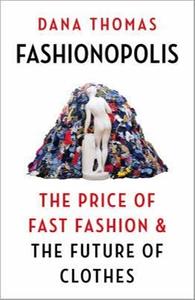_Michael_Roberts_Maconochie_Photography_.jpg)
|
|
| photo: Michael Roberts/ Maconochie Photography |
|
Dana Thomas is the author of Gods and Kings: The Rise and Fall of Alexander McQueen and John Galliano and Deluxe: How Luxury Lost Its Luster. She lives in Paris and is a regular contributor to the New York Times Style section. Her book Fashionopolis: The Price of Fast Fashion--and the Future of Clothes has just been released by Penguin Press.
Fashionopolis highlights the importance of learning the origin stories of our clothes. What's the origin story of Fashionopolis?
When I was on a book tour for Deluxe in 2007, in one day I heard two bits of news that made my radar go up. First, Oscar de la Renta CEO Alex Bolen told me over breakfast at the Royalton that the company had just bought the family-owned factory in the Bronx that produced its evening gowns. Bolen said that he liked that he could hop in a car and head up to the factory to see how production was going--that it was close by, that they had control of their supply chain. That afternoon, I was at a Brooks Brothers event, and the company spokesman told me that the brand was soon opening a factory in Long Island City to produce all of its neckties. The company was bringing that manufacturing back to the U.S., and it was only 20 minutes away from headquarters on Madison Avenue. This got me thinking: After decades of offshoring, is garment manufacturing reshoring happening? I snooped around, and it felt too early to write something about it--reshoring wasn't quite a trend yet. But I kept a file in my drawer, and if I saw a story on a company bringing manufacturing back to the U.S., I clipped or printed it and dropped it into the file.
I was working on a book proposal on the subject when John Galliano flamed out at Dior, and I put that proposal aside to write my second book, Gods and Kings. Once that book was published and I'd finished touring, I was cleaning up my desk and file drawers and came across the "Made in the USA" file. I started snooping around again, and found that in those intervening eight years, a reshoring movement had truly taken form. What's more, sustainability was becoming increasingly important. Deluxe, for me, was about companies that sacrifice integrity for the sake of profits. Gods and Kings was about sacrificing the creative for the sake of profits. And Fashionopolis is about sacrificing humanity and the environment for the sake of profits. They are, in a sense, a trilogy.
Your book is scrupulously researched, with a terrific range of interview subjects from around the globe. How did you find all the innovators and activists you profiled?
Some--such as Natalie Chanin, Stella McCartney and Julie Gilhart--I knew through my 30 years of covering the fashion industry. They, in turn, suggested others: it was Natalie Chanin who told me, for example, about organic cotton doyenne Sally Fox. Stella McCartney turned me on to Evrnu, Bolt Threads and Modern Meadow. I learned about Selfridges' movement in sustainability from its annual New Year campaign, Bright New Things. And one of the Bright New Things I read about was Unmade. Basically, I just did what reporters do: follow leads, ask for more leads, take advantage of chance introductions, write down everything and keep every contact that comes my way. I call it "casting a wide net." Pull it in, and it's full of fish.
 Fashionopolis is wonderful fodder for a dilemma I've been having. I don't think we should go back to a time when one couldn't leave the house without a hat on, but when I watch, say, The Dick Van Dyke Show, in which even characters' casual clothes are dapper, I can't help but feel that we've lost something. Is it unconscionable to think this way when being permitted to wear T-shirts, sweatpants and other low-cost items in public has made life easier for people who don't have the financial reserves for tailored clothing?
Fashionopolis is wonderful fodder for a dilemma I've been having. I don't think we should go back to a time when one couldn't leave the house without a hat on, but when I watch, say, The Dick Van Dyke Show, in which even characters' casual clothes are dapper, I can't help but feel that we've lost something. Is it unconscionable to think this way when being permitted to wear T-shirts, sweatpants and other low-cost items in public has made life easier for people who don't have the financial reserves for tailored clothing?
I would say part of the lifestyle that existed during the era of The Dick Van Dyke Show--at least when it comes to consuming fashion--is worth harking back to. Meaning: one bought much, much less, and wore it much, much more. The average female consumer didn't have 10 little black dresses; she had one. And it could be dressed up with pearls, or a brooch, or a scarf, or a jacket, or, yes, a hat. I still have my mother's LBD from then. It's well-made, it's stylish, it's timeless. It's as old as I am, yet every time I wear it, I get compliments. So, I'd say, don't buy 10 hoodies; buy one good suit instead. Chic, after all, is chic.
This is probably a wildly unfair question, but I can't resist: Do you know the origin stories of the clothes you are wearing right now?
Ha! I’m wearing an eight- or 10-year-old Uniqlo navy blue washed-silk shift. The label says it was made in China. So, I'm slightly busted, because it is from a fast fashion brand (though when I bought it, I don't think I realized Uniqlo was "fast fashion"). But I have not consumed it in a fast fashion manner. Thank goodness it wasn't made in Bangladesh. I woulda changed! --Nell Beram, author and freelance writer

